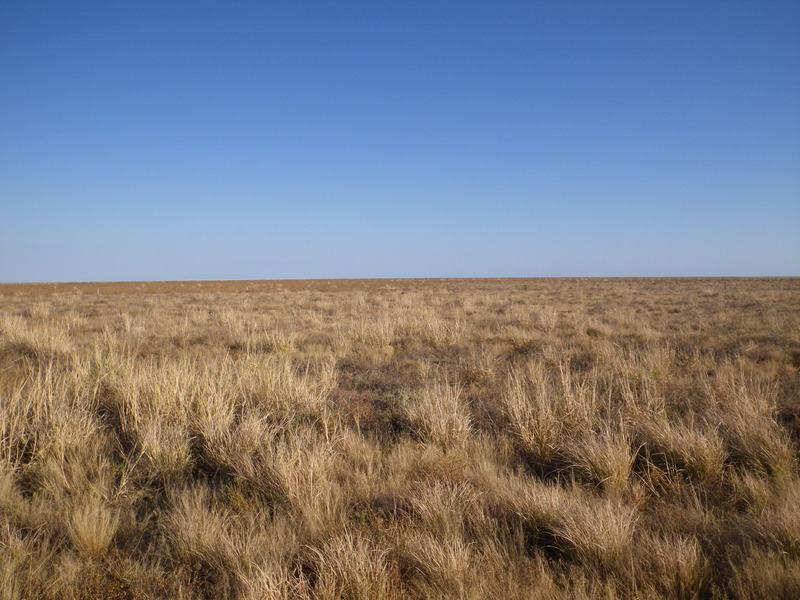
Broome has three claims to fame. It was a great center for the collection of mother of pearl. It was attacked in a Japanese air raid on March 3rd, 1942. And it is a great tourist attraction.
Derby has one claim to fame: the largest tides in Australia.
But first, a bit more about the Great Sandy desert.
The words "Great Sandy Desert" to me evoke an image of sand dunes and vast open spaces. And deep, endless sand. Not a grassland thickly covered in flowering acacia bushes.
But where this road goes through, there are no sand dunes such as I saw way back on the first day of this road trip, in Wanagarren Nature Reserve.
From the road, there is no easy access to 80-mile beach, because the road runs about 20 km inland. There was one access, but I did not take it. But still, the road is relatively close to the shore.
I guess that this area gets some humidity from the nearby ocean, and the real desert is further inland. Evidence of the faraway desert is the lack of rivers in this area. Everywhere else the road crosses many rivers, even though they are dry in this season, but here there are no rivers.
This part of Australia seems to get two major seasons: wet season and dry season. The exact dates vary by location, but this seems to be the dry season throughout. The dry season is the best season to visit. I suspect things might look very different in the wet season.
Along the road, there is plenty of vegetation, except where the cattle have eaten it and there is only short grass.

The unpaved side roads from the Great Northern Highway do show quite a bit of sand, and when I pulled over for my breakfast, I was careful not to stay in the sandiest parts, lest I get stuck.
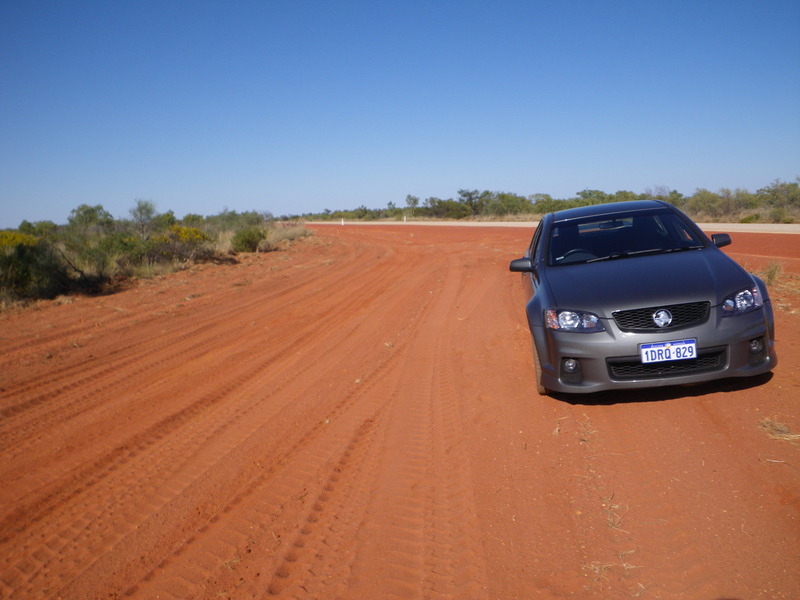
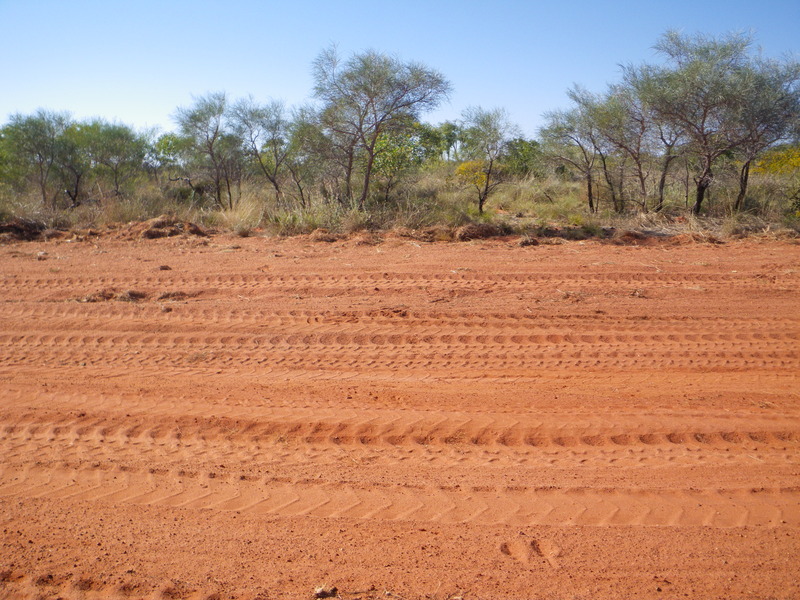
The area around Broome is called Pindan, a native word which refers to the reddish color of the soil and is now used to refer to the region itself.
As well as all the bushes and grass, I did see some wallabies in the bush, though they did their best to hide from me. So this is certainly not a wasteland.
Along the way, I found a dead cangaroo on the road. I dragged it off the road. Without measuring carefully, I estimate that it was about 2m long from the tip of the nose to the end of the tail, and probably weighed around 40kg. It was easy to drag off the road. This is a full-size cangaroo, not like the little wallabies I saw alive yesterday and today.
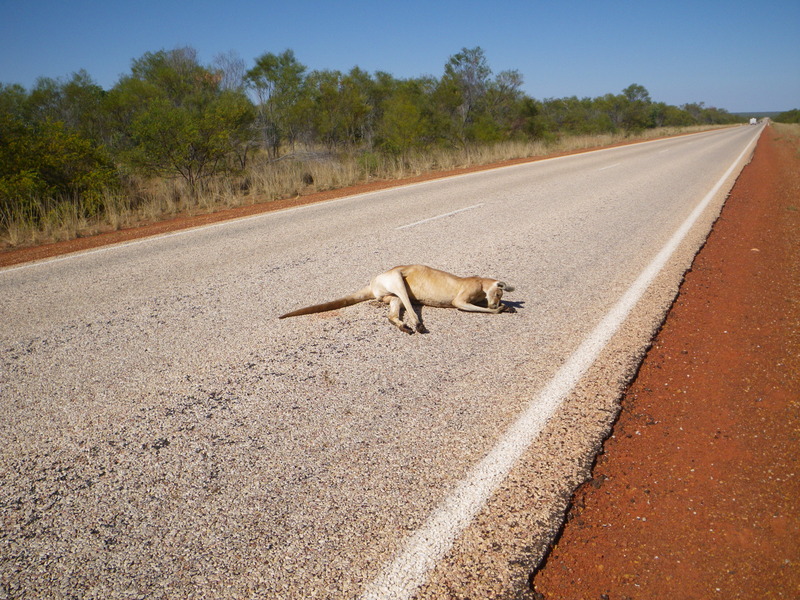
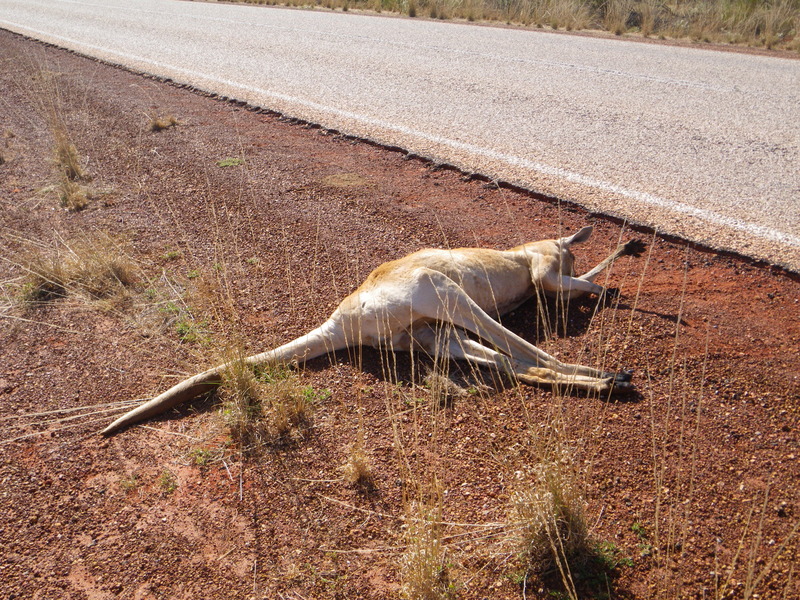
The thought crossed my mind that this would be a good time to taste cangaroo steaks. Fortunately I have no knife and no cooler, so I left the cangaroo for the ravens.
I did get the mirage effect from driving through this very flat country.

What looks like a lake in the distance is just a reflection.
Arriving to Broome, I saw the start of the Cape Leveque road. It is 201 unpaved kilometers to Cape Leveque. As I understand it, rental car companies do not allow their customers to take their cars on roads such as the Cape Leveque road.
From 1800 to 1804 two French ships, the Geographe and the Naturaliste, explored the coast of Western Australia under the command of Captain Nicholas Baudin. Although the two ships were separated after reaching Australia, between them they are responsible for many of the French names along the coast, including the Gascoyne river in Carnarvon and Cape Leveque.
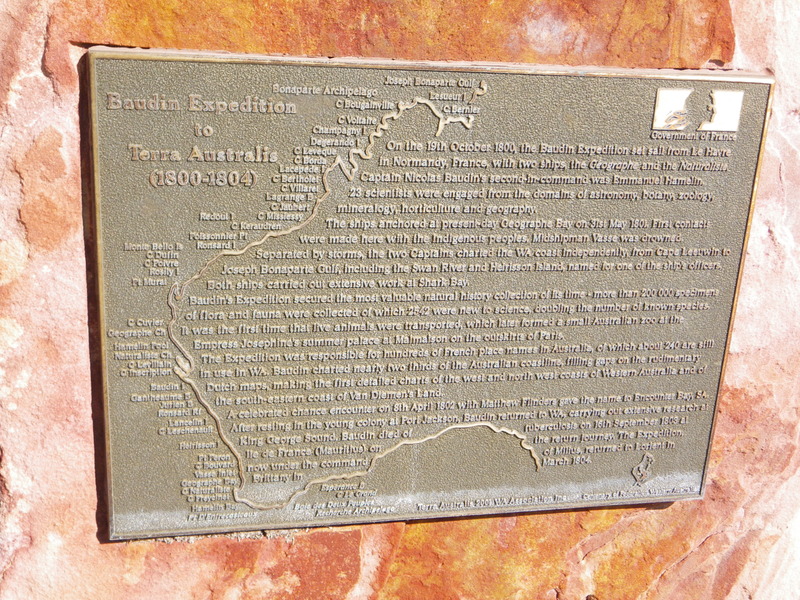
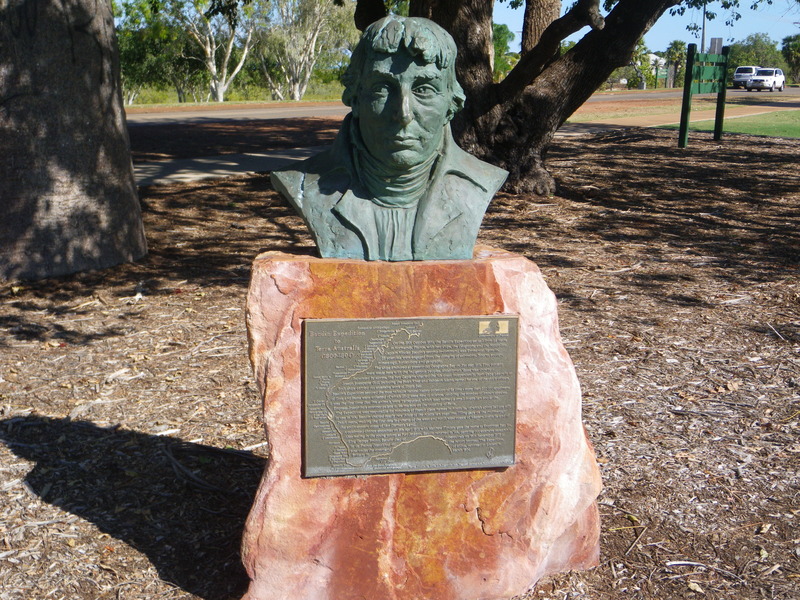
Captain Baudin died on the way back to France, in Mauritius, of tuberculosis.
Many years later, in the 1870s, some brave skippers sailed all the way over from Sydney to Broome. In the area of Broome, they found many shells that were suitable for producing mother of pearl, the shiny stuff inside the shell. Since most buttons in the world at the time were made of mother of pearl, this was a very profitable enterprise.
Soon, these enterpreneurs founded the town of Broome. They had assistance from the Australian government, which wanted to tax their substantial profits. The old customs house, where the taxes were collected, is now a museum.

Broome itself is quite beatiful, the pindan soil contrasting nicely with the coler of the water.

The skippers were not themselves diving to collect the shells. Conditions were dangerous. In particular, divers often got "the bends" from staying below too long and then rising to the surface too quickly. The bends were very painful and sometimes fatal.
So the pearlers hired aboriginal divers, who after all, had been diving after the shells since time immemorial. The aboriginals had used the shells for their own adornment.
After a while, there were no willing aboriginals left, and the pearlers resorted to kidnapping aboriginals and forcing them to dive. This practice of blackbirding was fairly common in the 1870s. It is the way the population of Easter Island was persuaded to work in the Chilean mines, for example. This had disastrous effects for the native population of Easter Island, and probably created good profits for the Chilean mine owners. Similarly, the pearling industry was very profitable for the owners of the pearling boats.
Eventually, the pearlers found willing divers among two outside populations: people from Koepang in West Timor, which was then part of the Dutch East Indies (Netherland East Indies or NEI), and Japanese. All went well for a few decades.
At the end of the 1800s Australia became independent. In 1901 the legislature passed a law that all immigrants to Australia should be of the Caucasian race, a policy known as White Australia.
This was likely to spell financial ruin for the pearling industry in Broome, which by that time was providing the majority of the mother of pearl for buttons the world over. Somehow the pearlers managed to obtain for Broome an exemption to the White Australia act. The non-whites were allowed to keep collecting pearls in the waters off the Dampier Peninsula. They were not, however, allowed to own property.
The bends kept affecting divers. Good diving tables were available, but divers who spent all day collecting shells sometimes got impatient and surfaced too quickly. In 1905 a decompression chamber was donated to the town of Broome, and used frequently to help divers with the bends.
Japanese and Koepangers each had their own area in Broome. At one point there was a riot in which Japanese and Koepangers fought against each other. All the white men in town were temporarily drafted into the police force to keep order.
The Japanese in particular were proving quite enterpreneurial, but of course they could not own property in Australia. So instead, they reached informal agreements with their former employers, whereby the Japanese would in effect run the mother of pearl business, and the whites would keep some of the profits and provide a legal front. In spite of the fact that the arrangement was skirting the law, Whites, Japanese, and Koepangers were all making money, the government was collecting taxes, and so the arrangement continued for several years.
After the attack on Pearl Harbor, Australia joined the United Kingdom in declaring war on Japan, and interned all Japanese citizens on its soil. This devastated the pearling industry in Broome, but Australia at this point had greater concerns than the buttons of the world.
The Japanese armies advanced through British-held Malaya and took Singapore, and were attacking Burma and the Netherland East Indies (NEI). In February 1942, after the Allies lost the battle of the Java Sea, many flights were organized to evacuate Dutch civilians from Jakarta and other places in the NEI. These flights were mostly in seaplanes. These seaplanes were known as flying boats because the lower part of the fuselage was shaped like a speedboat.
Many flying boats landed in Broome on their way to Perth. Broome was considered safe from the Japanese.
The Japanese air force was ordered to stop the escape of the refugees. On march 3rd, 1942, a flight of Japanese fighters attacked all the planes on the ground and in the water in Broome, and shot down an American military aircraft that had managed to take off from Broome airport at the beginning of the attack. Because of the low tide, the flying boats were stuck and unable to take off.
Many of the flying boats were packed with refugees. Many of the refugees were not able to escape and died either by fire, or by drowning.
The Broome museum tells in beautiful detail the stories of the pearlers, including the "dark chapter" of forcing aboriginals to fish for pearls, and the Japanese attack on Broome and the death of military and civilian personnel. Unfortunately, they do not allow pictures, so all you have are my words, and this sign I saw in a park.
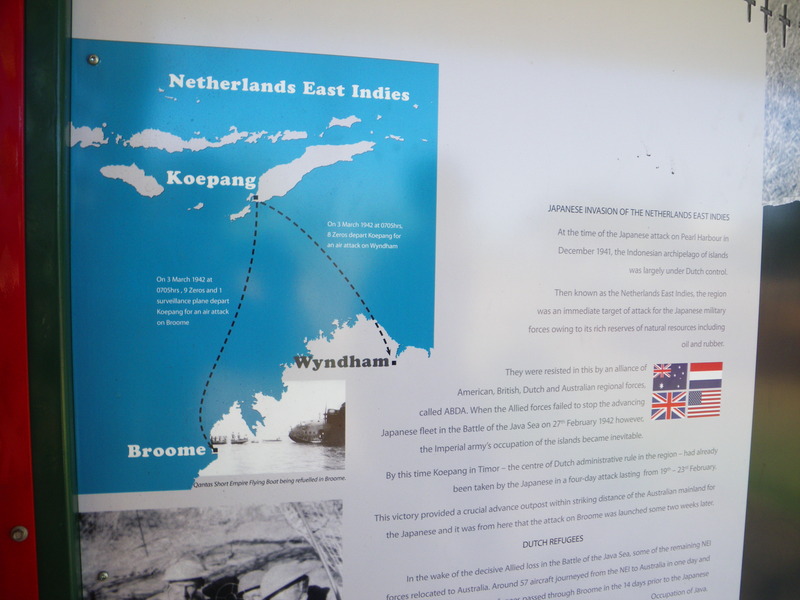
The third major claim to fame for Broome is as a tourist destination. As well as all its history, Broome has some beautiful beaches, especially Cable Beach, which gets beatiful sunsets.
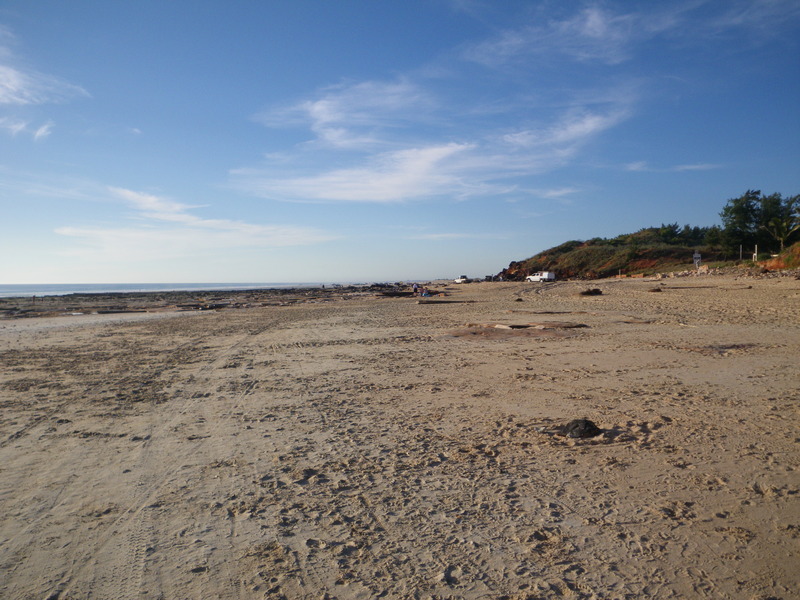
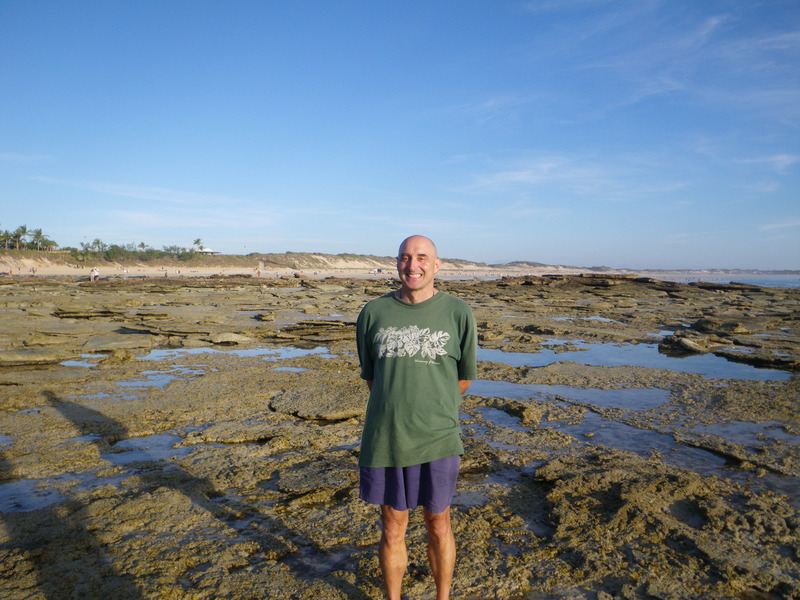
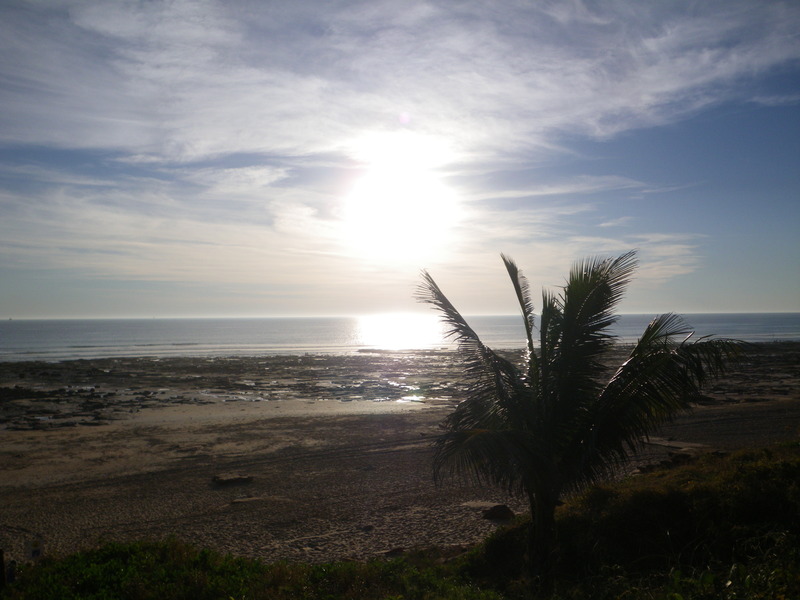
Personally, I enjoyed some of the nature in Broome, especially the birds.
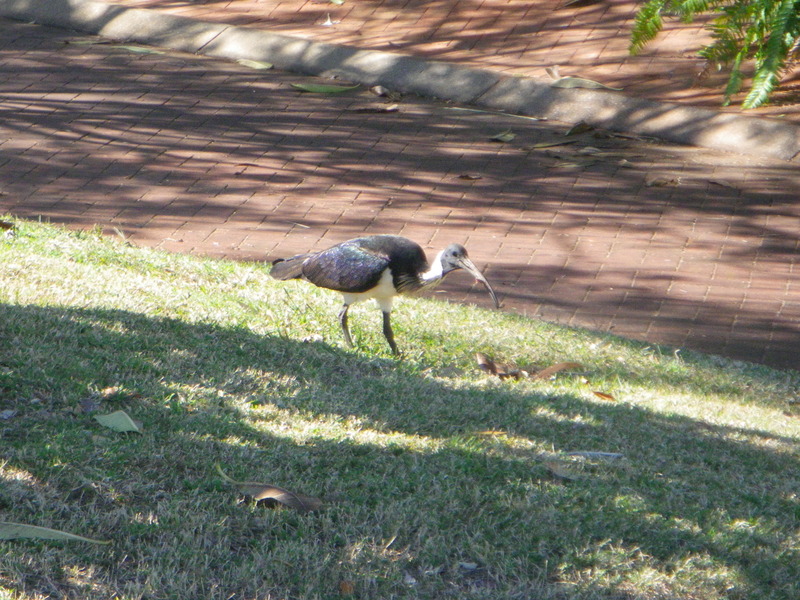
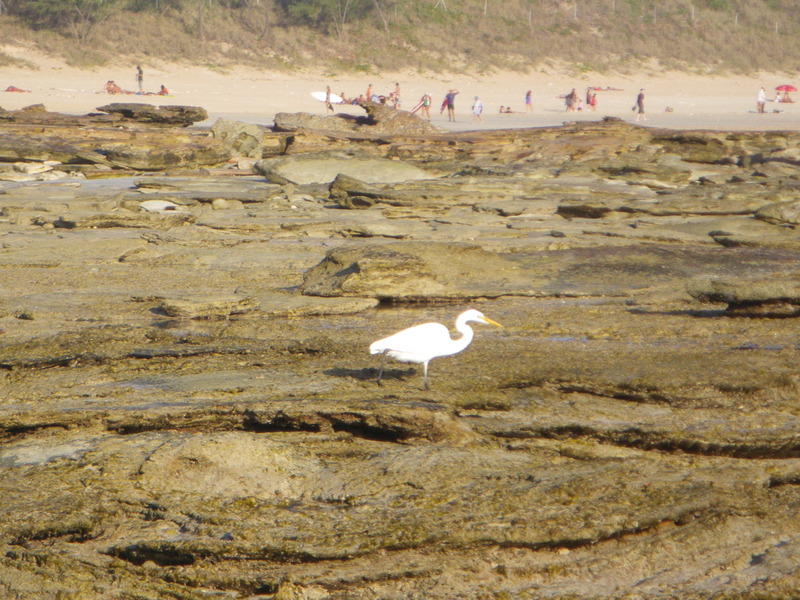
I was told this tree is called "Terminalia".
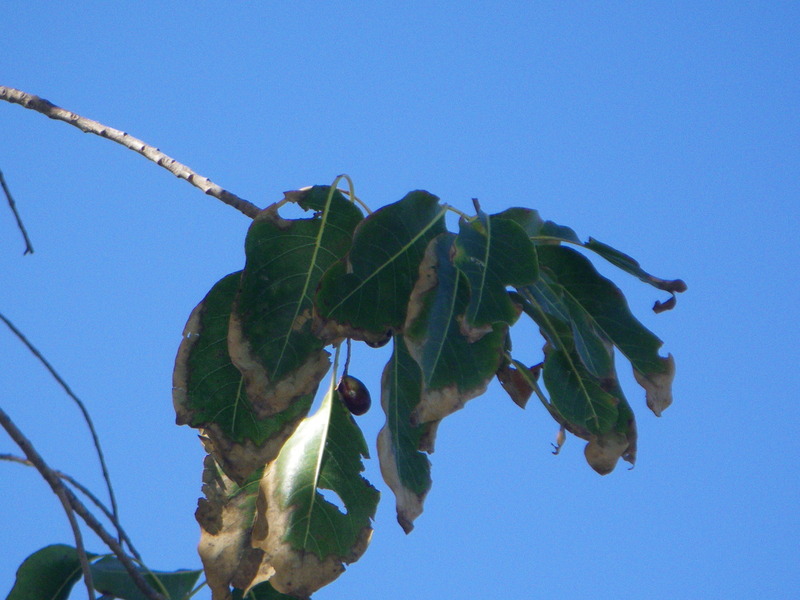
This crab, on cable beach, makes interesting patterns in the sand.
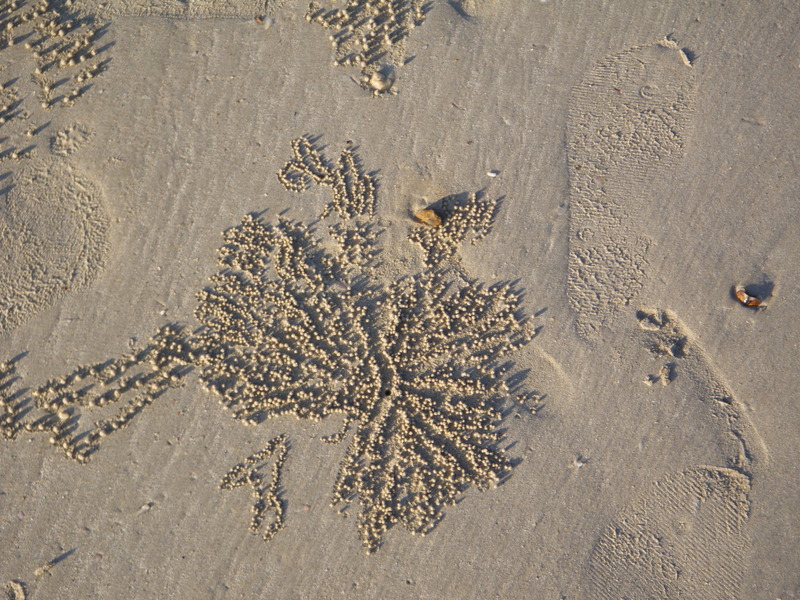
Derby's major claim to fame are huge tides, reaching to 11m, and sometimes creating "horizontal" waterfalls as the water gushes out from pools that have been filled at high tide. And a large population of Boabs, the native Australian trees that are related to the Baobab that grows in Southern Africa. However, I got to Derby at night, and didn't get pictures of either.
As far as the horizontal waterfalls are concerned, the most popular way to see them seems to be a week-long cruise, so I may not get to see them at all. I did see a sign advertising a discounted 11-day cruise, for only AU$6,400 instead of the usual AU$8,000 or so.